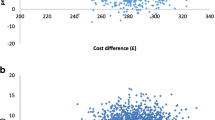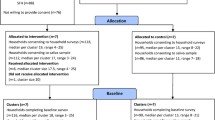Abstract
Background Exposure to secondhand smoke (SHS) is a significant contributor to ill health in children. A study was undertaken to determine the effectiveness of two brief multi-strategic child health nurse delivered interventions in: decreasing the prevalence of infants exposed to SHS; decreasing the prevalence of smoking amongst parent/carers of infants and increasing the prevalence of household smoking bans. Methods This study was a 3 arm, cluster randomised controlled trial. Clusters were 39 community based well child health clinics in one local area health service. Clinics were stratified according to annual number of client appointments and then randomly assigned in a 1:1:1 ratio, (Intervention 1: Intervention 2: Control), with 13 clinics in each cluster. Parents/carers of infants in the intervention groups received a brief multi-strategic intervention from child health nurses during clinic consultations. Treatment condition 1 included computer delivered risk assessment and feedback and nurse brief advice. Treatment condition 2 included all elements of Treatment condition 1 with the addition of biochemical feedback of infant SHS exposure. Results When compared to the Control group at 12 months, no significant differences in the prevalence of infant exposure to SHS were detected from baseline to follow-up for Treatment condition 1 (OR 1.16, 95 % CI 0.73–1.85, p = 0.53) or Treatment condition 2 (OR 1.30, 95 % CI 0.88–1.92, p = 0.19) Similarly, no significant differences were detected in the proportion of parent/carers who reported that they were smokers (T1:OR 0.95, 95 % CI 0.78–1.15, p = 0.58 and T2:OR 0.97, 95 % CI 0.80–1.18, p = 0.77), or in the proportion of households reported to have a complete smoking ban (T1:OR 1.21, 95 % CI 0.89–1.64, p = 0.23 and T2:OR 1.06, 95 % CI 0.79–1.43, p = 0.68). Conclusions Further research is required to identify effective interventions that can be consistently provided by child health nurses if the potential of such settings to contribute to reductions in child SHS exposure is to be realised.

Similar content being viewed by others
References
Arditi, C., Rège-Walther, M., Wyatt, J., Durieux, P., & Burnand, B. (2012). Computer-generated reminders delivered on paper to healthcare professionals; effects on professional practice and health care outcomes. Cochrane Database of Systematic Reviews, (12), CD001175. doi:10.1002/14651858.CD001175.pub3.
Baxi, R., Sharma, M., Roseby, R., et al. (2014). Family and carer smoking control programmes for reducing children’s exposure to environmental tobacco smoke. The Cochrane Database of Systematic Reviews, 3, CD001746.
Benowitz, N. L. (1996). Cotinine as a biomarker of environmental tobacco smoke exposure. Epidemiologic Reviews, 18(2), 188–204.
Borland, R., Yong, H.-H., Cummings, K. M., Hyland, A., Anderson, S., Fong, G. T. (2006). Determinants and consequences of smoke-free homes: findings from the International Tobacco Control (ITC) Four Country Survey. Tobacco Control, 15(suppl 3), iii42-iii50.
Carson, K. V., Verbiest, M. E., Crone, M. R., et al. (2012). Training health professionals in smoking cessation. Cochrane Database of Systematic Reviews, 5, CD000214.
Centre for Epidemiology and Evidence. (2012). 2009-2010 Summary Report from the New South Wales Child Health Survey. NSW Ministry of Health.
Centre for Epidemiology and Evidence. (2009). Summary Report on Adult Health from the New South Wales Population Health Survey. Sydney.
Committee on Environmental Health. (2009). Committee on Substance Abuse, Committee on Adolescence, Committee on Native American Child Health. Tobacco Use: A Pediatric Disease. Pediatrics, 124(5), 1474–1487.
Curry, S. J., Keller, P. A., Orleans, C. T., & Fiore, M. C. (2008). The role of health care systems in increased tobacco cessation. Annual Review of Public Health, 29(1), 411–428.
Daly, J., Wiggers, J., & Considine, R. (2001). Infant exposure to environmental tobacco smoke: A prevalence study in Australia. Australian and New Zealand Journal of Public Health, 25(2), 132–137.
Dempsey, D. A., Meyers, M. J., Oh, S. S., et al. (2012). Determination of Tobacco Smoke Exposure by Plasma Cotinine Levels in Infants and Children Attending Urban Public Hospital Clinics. Archives of Pediatrics and Adolescent Medicine, 166(9), 851–856.
DiClemente, C. C., Marinilli, A. S., Singh, M., & Bellino, L. E. (2001). The role of feedback in the process of health behavior change. American Journal of Health Behavior, 25(3), 217–227.
Fiore, M. C., Jaén, C. R., Baker, T. B., et al. (2008). Treating Tobacco Use and Dependence: 2008 Update. Clinical Practice Guideline.
Hughes, J., Keely, J., & Naud, S. (2004). Shape of the relapse curve and long-term abstinence among untreated smokers. Addiction, 99(1), 29–38.
Jepson, R. G., Harris, F. M., Platt, S., & Tannahill, C. (2010). The effectiveness of interventions to change six health behaviours: a review of reviews. BMC Public Health, 10(1), 1–16.
Johnson-Kozlow, M., Hovell, M. F., Rovniak, L. S., Sirikulvadhana, L., Wahlgren, D. R., Zakarian, J. M. (2008). Fidelity issues in secondhand smoking interventions for children. Nicotine & Tobacco Research, 10(12), 1677–1690.
Kallio, K., Jokinen, E., Hämäläinen, M., et al. (2006). Impact of repeated lifestyle counselling in an atherosclerosis prevention trial on parental smoking and children’s exposure to tobacco smoke. Acta Paediatrica, 95(3), 283–290.
Kwok, M. K., Schooling, C. M., Ho, L. M., et al. (2008). Early life second-hand smoke exposure and serious infectious morbidity during the first 8 years: evidence from Hong Kong’s “Children of 1997” birth cohort. Tobacco Control, 17(4), 263–270.
Matt, G. E., Bernert, J. T., & Hovell, M. F. (2008). Measuring Secondhand Smoke Exposure in Children: An Ecological Measurement Approach. Journal of Pediatric Psychology, 33(2), 156–175.
Matt, G., Wahlgren, D., Hovell, M., et al. (1999). Measuring environmental tobacco smoke exposure in infants and young children through urine cotinine and memory-based parental reports: empirical findings and discussion. Tobacco Control, 8(3), 282–289.
NSW Department of Health. (2011). Child and Family Health Nursing: Professional Practice Framework 2011-2016. Sydney.
Öberg, M., Jaakkola, M. S., Woodward, A., Peruga, A., & Prüss-Ustün, A. (2011). Worldwide burden of disease from exposure to second-hand smoke: a retrospective analysis of data from 192 countries. The Lancet, 377(9760), 139–146.
Orton, S., Jones, L. L., Cooper, S., Lewis, S., & Coleman, T. (2014). Predictors of children’s secondhand smoke exposure at home: a systematic review and narrative synthesis of the evidence. PLoS ONE, 9(11), e112690.
Pojer, R., Whitfield, J. B., Poulos, V., Eckhard, I. F., Richmond, R., Hensley, W. J. (1984). Carboxyhemoglobin, cotinine, and thiocyanate assay compared for distinguishing smokers from non-smokers. Clinical Chemistry, 30(8), 1377–1380.
Rosen, L. J., Myers, V., Hovell, M., Zucker, D., & Ben Noach, M. (2014). Meta-analysis of parental protection of children from tobacco smoke exposure. Pediatrics, 133(4), 698–714.
Rosen, L. J., Noach, M. B., Winickoff, J. P., & Hovell, M. F. (2012). Parental smoking cessation to protect young children: a systematic review and meta-analysis. Pediatrics, 129(1), 141–152.
Royal College of Physicians. (2010). Passive smoking and children: A report of the Tobacco Advisory Group of the Royal College of Physicians. London.
SAS Institute Inc. (2001). SAS Software Version 9.3 for Windows [computer program]. Cary, NC: SAS Institute Inc.
Severson, H. H., Andrews, J. A., Lichtenstein, E., Wall, M., & Akers, L. (1997). Reducing maternal smoking and relapse: long-term evaluation of a pediatric intervention. Preventive Medicine, 26(1), 120–130.
Stead, L., Hartmann-Boyce, J., Perera, R., Lancaster, T. (2013). Telephone counselling for smoking cessation. Cochrane Database of Systematic Reviews, (8), CD002850. doi:10.1002/14651858.CD002850.pub3.
Stead, L. F., Perera, R., Bullen, C., et al. (2012). Nicotine replacement therapy for smoking cessation. The Cochrane Database of Systematic Reviews, 11, CD000146.
US Department of Health and Human Services. (2014). The Health Consequences of Smoking—50 Years of Progress: A Report of the Surgeon General. Atlanta, GA: U.S. Department of Health and Human Services, Centers for Disease Control and Prevention, National Center for Chronic Disease Prevention and Health Promotion, Office on Smoking and Health.
Wakefield, M., Banham, D., McCaul, K., et al. (2002). Effect of feedback regarding urinary cotinine and brief tailored advice on home smoking restrictions among low-income parents of children with asthma: a controlled trial. Preventive Medicine, 34(1), 58–65.
Winickoff, J. P., Nabi-Burza, E., Chang, Y., et al. (2014). Sustainability of a Parental Tobacco Control Intervention in Pediatric Practice. Pediatrics, 134(5), 933–941.
Yılmaz, G., Karacan, C., Yöney, A., & Yılmaz, T. (2006). Brief intervention on maternal smoking: a randomized controlled trial. Child: Care, Health and Development, 32(1), 73–79.
Zakarian, J. M., Hovell, M. F., Sandweiss, R. D., et al. (2004). Behavioral counseling for reducing children’s ETS exposure: implementation in community clinics. Nicotine & Tobacco Research, 6(6), 1061–1074.
Acknowledgments
We gratefully acknowledge the Project Advisory Group, consisting of members of Child and Family Health Nursing-Hunter New England Health, and The Centre for Health Research & Psycho-oncology (CHeRP). Also the child health nurses from participating clinics, the parent/carers and infants who participated in the study as well as Dr J Lynn Francis and Mr Christophe Lecathelinais for their support with the analysis.
Funding
This research was made possible by funding from The Financial Markets Foundation for Children, The Community Health and Anti Tuberculosis Association, The Centre for Health Research & Psycho-oncology (CHeRP) and with infrastructure support from the Hunter Medical Research Institute.
Author information
Authors and Affiliations
Corresponding author
Rights and permissions
About this article
Cite this article
Daly, J.B., Freund, M., Burrows, S. et al. A Cluster Randomised Controlled Trial of a Brief Child Health Nurse Intervention to Reduce Infant Secondhand Smoke Exposure. Matern Child Health J 21, 108–117 (2017). https://doi.org/10.1007/s10995-016-2099-5
Published:
Issue Date:
DOI: https://doi.org/10.1007/s10995-016-2099-5




